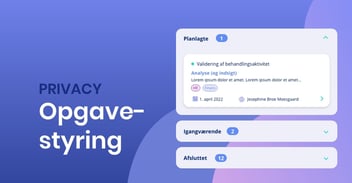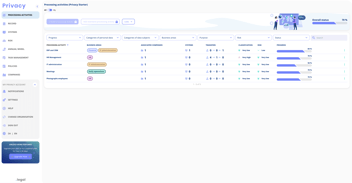Accessibility Act: The Accessibility Act is now in force – is your business ready?
On 28 June 2025, the Danish accessibility law came into force, and from that date all new digital services must comply with a range of specific accessibility requirements. This means that accessibility is no longer something you can consider "nice to have" – it has become a fixed and mandatory part of digital legislation. For many businesses, this is an area where there should already be action behind the words.

If you have launched new features, apps, platforms, or webshops since June, then the accessibility law rules apply to you now. And it's not just about complying with the law, but also about offering a solution that works for all users – regardless of their prerequisites and needs.
Who is covered by the accessibility law?
The accessibility law builds on the EU directive on accessibility of products and services (European Accessibility Act, directive 2019/882). In Denmark, the rules are implemented through law no. 801 of 9 June 2022, which specifies how and when businesses must comply with the new accessibility requirements.
The accessibility law applies specifically to:
- Private businesses that offer digital services to consumers (B2C)
- Services such as e-commerce, banking and financial services, transport, communication, and e-books
- Businesses with more than 10 employees or an annual turnover of over 2 million euros
Micro-enterprises – defined as businesses with under 10 employees and under 2 million euros in turnover – are exempt from the accessibility law, but many small and medium-sized enterprises are still covered by the new rules.
In short: If you sell digital services to private individuals and are a bit larger than an entrepreneur with a webshop in the basement, then the accessibility law rules apply to you.
Specific services covered by the accessibility law
To understand whether your business is covered, it's important to know the specific services that the accessibility law covers:
- E-commerce services: Webshops, online marketplaces, and digital payment solutions
- Banking and financial services: Online banking, insurance portals, investment platforms
- Transport services: Ticketing systems, app-based transport services
- Telecommunications: Customer portals, support services, communication platforms
- Media services: Streaming, e-books, audiovisual content
- Travel services: Booking systems, travel portals
Why is accessibility important for your business?
Accessibility is fundamentally about ensuring equal access for people with disabilities – whether they navigate with screen readers, use keyboard navigation, or need simple and clear structure. But even without legal requirements, investing in accessibility makes good business sense.
Concrete benefits of prioritising accessibility
Businesses that systematically invest in accessibility often experience the following positive effects:
- Better user experience for everyone – not just those with disabilities. Accessible solutions are usually more intuitive and easier to navigate for all users.
- Increased conversion and lower dropout rates in checkout flows. When the process is simple and logical, more users complete their purchases.
- Fewer support enquiries because users can more easily find what they're looking for and understand how the solution works.
- Better SEO results because accessibility and search engine friendliness overlap significantly. Structured content helps both users and search engines.
- A stronger brand in terms of responsibility and inclusion, which is becoming increasingly important for consumers and B2B customers.
Additionally, the accessibility law now makes it a proper compliance discipline. If you don't comply with the requirements, you risk enforcement orders or ultimately fines – and this no longer applies only to the public sector.
What should you do to comply with the accessibility law now?
If you have launched new services after 28 June 2025, they must already be accessible in accordance with the accessibility law. If you don't have this under control, you need to act quickly. For existing services, the deadline is set for 28 June 2030, but this doesn't mean you can wait until the last minute – implementing accessibility takes time, and the more you can reuse and learn from now, the easier the transition will be later.
Practical approach to get started
- Conduct a quick analysis of your most important user flows
- Prioritise the most critical areas (purchase, payment, login, support)
- Implement basic accessibility principles
- Test the solutions both automatically and manually
- Document your work and create an accessibility statement
Concrete checklist for compliance with the accessibility law
To help you gain an overview and plan the work step by step – both technically, legally, and organisationally – we have developed a practical approach:
📋 Practical checklist for accessibility law
Use this checklist to gain an overview and plan your accessibility work step by step. Print it out or save the page for later use.
🛠️ Technical requirements
⚖️ Legal requirements
👥 Organisational requirements
🚀 Ready to tackle the accessibility law?
Use the .legal platform to organise and follow up on your accessibility work
If you want to work with the tasks actively, you can also use our task module in the .legal platform – it's free to use and helps keep track of progress, ownership, and deadlines.
Documentation: What does the accessibility law require?
Two documents are central if you want to show that you take accessibility seriously and work systematically with it: The Accessibility Statement and the Accessibility Policy.
Accessibility statement – your mandatory public status
The statement is mandatory according to the accessibility law and must be publicly accessible – for example in the footer of your website. It must specifically describe:
- Scope and coverage: Which services and solutions the statement covers, and which are possibly excluded.
- Compliance level: Whether you meet the accessibility requirements fully, partially, or not at all – and if partially, which areas are missing.
- Specific problems: Which specific problems exist, where they occur, and what you actively do to solve them.
- Contact information: How users can provide feedback about accessibility problems and contact you with questions or complaints.
- Future plan: When you expect to have solved known problems and how you work with continuous improvement.
You should update the statement at least once a year or when there are major changes to your services. And most importantly: it must be honest and transparent. It's better to acknowledge problems and show that you're actively working on them than to try to hide them.
Accessibility policy – good internal practice
An accessibility policy is not a direct requirement in the accessibility law, but it's a strong signal – both internally and externally – that accessibility is an integrated part of your corporate culture and workflows.
An effective accessibility policy:
- Formulates your vision and overall approach to digital inclusion and accessibility.
- Clearly states who in the organisation has overall responsibility and how responsibility is distributed.
- Describes specifically how you test, quality assure, and train employees in accessibility.
- Shows how you continuously follow up and improve your accessibility work over time.
- Defines your standards and which guidelines you follow (e.g., WCAG 2.1 AA level).
The policy is particularly useful if you work with many different digital solutions, have multiple teams involved in development, or want to be able to document your professional approach to customers, partners, and authorities.
Tools to comply with the accessibility law
You don't need to reinvent the wheel when it comes to working with accessibility. There's already a wide range of tools and solutions that can help you get started – from free scans to professional platforms.
Free tools to get started (good for quick overview)
- WAVE (Web Accessibility Evaluation Tool) Browser plugin that shows specific errors directly on your website. Perfect for getting a first impression of where you stand.
- axe DevTools Developer-friendly Chrome extension that provides detailed reports and specific improvement suggestions.
- Lighthouse Built into Chrome DevTools and provides performance, SEO, and accessibility analysis in one tool.
- Pa11y Command-line tool for technical analysis that can be integrated into automated test flows.
Professional platforms for larger needs or continuous monitoring
- Siteimprove Danish platform with strong compliance focus and good integration with Danish business needs.
- axe Monitor Enterprise solution with deep analysis and ability for continuous monitoring of your entire digital setup.
Important limitation with automated tools
Be aware that automated scans only catch part of the problems – typically around 30-40 percent. The rest requires manual testing and preferably also testing with real users who actually navigate with assistive tools like screen readers or keyboards.
This means you can't rely solely on automated tools but must combine them with human evaluation and user testing to get a complete picture of how accessible your solutions actually are.
Important deadlines and implementation timeline for accessibility law
|
Date |
Requirement |
Applies to |
|
28 June 2025 |
New digital services must be accessible |
All services launched after this date |
|
28 June 2030 |
Existing services must be accessible |
All existing services launched before June 2025 |
Although 2030 may sound far away, it's crucially important to think about implementation well in advance – especially if you have many different systems or complex solutions. Accessibility isn't a "project" you roll out over a month. It needs to be strategically integrated into maintenance and ongoing development going forward.
Suggested implementation timeline
2025 (Now)
- Analysis of existing services
- Implementation of basic accessibility on new services
- Creation of accessibility statement
- Training of key employees
2026-2027
- Systematic review of existing services
- Implementation of accessibility on high-priority areas
- Development of internal processes and tools
- Regular user testing and feedback
2028-2029
- Completion of accessibility on all existing services
- Optimisation and fine-tuning
- Preparation for 2030 deadline
- Documentation and quality assurance
2030 and onwards
- Ongoing maintenance and improvement
- Integration into all new projects from the start
- Regular evaluation and updates
A pragmatic approach to getting started with the accessibility law
The most important advice is to get started – even if you don't have everything perfectly in place yet. Accessibility is a journey, not a destination, and it's better to take the first steps now than to wait for the perfect plan.
Start with the most important user flows
Focus first on the areas where users encounter you and expect things to work optimally:
- Purchase and ordering processes – from product display to completed transaction
- Payment and checkout – critical flows where users invest time and money
- Login and account creation – basic access to your services
- Customer support and contact – where users seek help when things go wrong
If you have control over these central areas, you've already covered a significant part of what's most important for both users and compliance with the accessibility law.
Think accessibility as an ongoing effort
It's crucial to understand that accessibility isn't something you implement once and then forget about. It needs to be integrated into your basic workflows – both in development, content production, and design.
When accessibility becomes a natural part of the way you work, it also becomes much easier to keep track of and maintain over time. It costs less in the long run and gives better results for users.
Advanced strategies for accessibility work
Integration into development processes
To get maximum effect from your accessibility efforts, you need to integrate it into your existing processes:
- Design phase: Think accessibility in already when you sketch new features and user flows.
- Development: Use automated tests as part of your CI/CD pipeline.
- Testing: Include accessibility testing as a fixed part of your QA process.
- Content: Train those who write content to create accessible text and media.
User involvement and feedback
One of the most valuable sources of insight is feedback from real users with different needs:
- Invite users with disabilities to test your solutions
- Create easy channels for accessibility feedback
- Follow up on enquiries and show that you take them seriously
- Use the feedback for continuous improvement
Pro tips for effective compliance with accessibility law
Based on experiences from businesses that have already successfully implemented accessibility, the following advice can save you time and frustration:
Organisational tips
- Build accessibility into your content and development processes – not as an aftercheck, but as an integrated part of the work from the start.
- Use the accessibility statement actively – it's not just an obligation, but an opportunity to show transparency and responsibility to your users.
- Train those who write and build your solutions – many accessibility errors start with ignorance about basic principles.
- Test continuously and involve users with different prerequisites in your development process.
- Document systematically what you do and what you have planned – both for compliance and for internal knowledge sharing.
Technical tips
- Start with semantic HTML – it's the foundation for good accessibility
- Use ARIA labels sensibly, but don't overdo it – too much can confuse
- Test with real screen reader software, not just automated tools
- Remember mobile phones and tablets too – accessibility applies across devices
- Implement skip-links for navigation, especially on content-heavy pages
Business strategic tips
- View accessibility as an investment in user-friendliness, not just compliance
- Use your accessibility work in marketing and CSR communication
- Consider getting certified according to international standards like ISO 14289
- Build competencies internally instead of only outsourcing – it's a long-term investment
Get help with accessibility law compliance
At .legal we don't cover the entire accessibility area, but we have developed tools that can make it significantly easier to organise, follow up on, and document the work of complying with the accessibility law:

How .legal can help you
Structured task management: Use our task module to divide and structure the implementation of accessibility into manageable pieces.
Integration with other compliance: Make accessibility a natural part of your other compliance work together with GDPR, information security, and other requirements.
Documentation and tracking: Create systematic controls, documentation, and clear responsibility distribution in your existing compliance setup.
Deadline management: Keep track of all the important dates and milestones in your accessibility work.
Reporting: Generate reports and status updates for management and authorities when necessary.
Get started with accessibility today
Do you need a concrete place to start with the accessibility law? We're happy to help make the work manageable and structured:
Ready to tackle the accessibility law systematically?
Book a demo | Get started free
Frequently asked questions about accessibility law
Basic questions about the accessibility law
When does the accessibility law come into force?
The Danish accessibility law came into force on 28 June 2025 for new digital services. Existing services have a deadline until 28 June 2030. This means that if you have launched something new after June 2025, it must already comply with the requirements now.
Which businesses are covered by the accessibility law?
Private businesses with over 10 employees or annual turnover over 2 million euros that offer digital B2C services such as e-commerce, banking and financial services, transport, communication, or media services. Micro-enterprises below these thresholds are exempt.
What happens if I don't comply with the accessibility law?
Businesses first risk enforcement orders from the relevant authorities with requirements to remedy the situation within a set deadline. If the order is not complied with, administrative fines may ultimately be imposed.
Do I need to create an accessibility statement?
Yes, an accessibility statement is mandatory according to the accessibility law and must be publicly accessible on your website. It must describe your compliance level and give users the opportunity to report problems.
What's the difference between the European Accessibility Act and the Danish law?
The Danish accessibility law implements the EU's European Accessibility Act (directive 2019/882) into Danish legislation. The requirements and deadlines are the same, but the Danish law specifies precisely how the rules should be complied with and enforced in Denmark.
Technical questions about implementation
Which technical standards should I follow?
The law refers to EN 301 549, which builds on WCAG 2.1 AA level. This means your content must be:
- Perceivable
- Operable
- Understandable
- Robust
Do mobile apps also need to be accessible?
Yes, mobile applications that offer the covered services must also comply with accessibility requirements. This applies to both iOS and Android apps.
What about third-party content on my website?
You are responsible for ensuring that third-party content (widgets, plugins, embedded content) also complies with accessibility requirements, or that accessible alternatives are available.
Does all my old content need to be updated by 2030?
Yes, all digital services that were in operation before June 2025 must be brought into compliance with accessibility requirements by 28 June 2030 at the latest.
Practical questions about implementation
How much does it cost to implement accessibility?
Costs vary significantly depending on how complex your services are and how accessible they are already. As a rule, it's cheaper to build accessibility in from the start than to retrofit it.
How long does it take to make a website accessible?
It depends on the size and complexity, but expect several months for a comprehensive website. Simple sites can often be brought up to standard in a few weeks.
Should I hire external consultants?
It's not necessary, but can be a good investment, especially to get off to a good start and train your internal teams. Many businesses combine external advice with internal capacity building.
How do I test if my solution is accessible?
Combine automated scanning (WAVE, axe) with manual testing and preferably also testing with real users who use assistive tools. No single testing method catches all problems.
Forward planning
What happens after the 2030 deadline?
Accessibility becomes an ongoing obligation. New features and content must be accessible from launch, and you must maintain accessibility on existing services.
Will there be more requirements in the future?
The EU continuously works to expand and clarify accessibility requirements. It's likely that requirements will be tightened and extended to more areas over time.
Should I also think about accessibility in B2B services?
Although the law focuses on B2C, it's good practice to also ensure accessibility in B2B services. Many B2B customers also have employees with disabilities.
Conclusion: Seize the opportunity for better digital inclusion
The accessibility law isn't just a regulatory burden – it's an opportunity to create better digital experiences for all your users. Businesses that take accessibility seriously now will not only comply with the law but also gain competitive advantages through better user-friendliness, higher conversion, and stronger brand.
The most important thing is to get started. Although the 2030 deadline may seem distant, accessibility isn't something you implement in a couple of months. Start with your most important user flows, build competencies in the organisation, and make accessibility a natural part of your digital workflows.
If you need help structuring and organising the work, please contact us. We can't make your website accessible, but we can make it much easier to plan, follow up on, and document the work – so you can focus on what provides the most value for your users.




.png?width=352&name=Kopi%20af%20Learn%20more%20(1).png)








.jpeg)

.jpg)
.jpg)



.jpg)

-1.png)



.jpeg)








.jpg)





